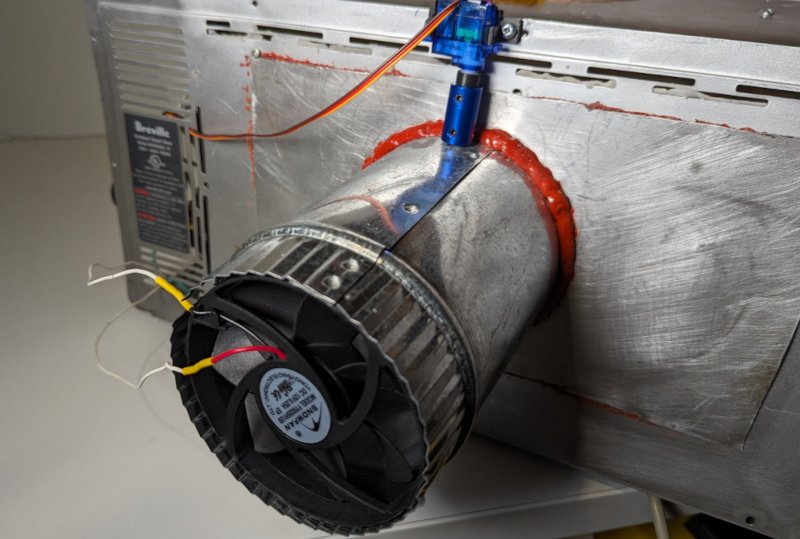Using a toaster oven to reflow PCBs isn’t anything new, but just using a toaster oven has some limitations. Making toast isn’t as complex as reflowing PCBs. [Nabil] decided to modify an oven to get better results. In fact, this was the second iteration and involved making a custom PCB to replace the one in the oven. You can see the unit in the video below.
Of course, unless you have the exact oven (a Breville BOV450XL), you won’t want to duplicate the board, but it might give you some good ideas. The new board has a 2.8-inch capacitive LCD, an ESP32, and a few sensors and actuators.
The other addition was an exhaust fan, which is a good idea, considering what you put inside. There’s also Raspberry Pi and lots of new holes in the case. Apparently, the oven was able to produce boards even with basic software using proportional control.
We’ve seen similar builds, but everyone has a little different take. This isn’t even the first one we’ve seen with a touchscreen.

















“The other addition was an exhaust fan, which is a good idea, considering what you put inside.”
Not the designer…but I suspect the fan is there to more accurately follow the reflow profile. After the “flow” you need to drop the temp faster than just passive cooling.
At least…that is why I would do it that way.
If I wanted to effectively get rid of fumes (without effecting chamber temp) I would use a hood vent above the unit.
I’d just stick it on the porch while doing reflow. I just spring for the assembly service for my common SMD components now, though, and hand-solder or hot-air the few ICs that aren’t available from LCSC (or Mouser CN if I want to go through PCBWay).
My smaller conveyor oven recommends a hood vent. Larger convection conveyor oven has 2 fan outlets…but they seem to be more isolated from the heating area and are for removing flux fumes (output isn’t nearly as hot as the oven).
In my case I have had CMs do the work…but the last 2 years I have been doing everything in house. PnP, ovens, soldering, etc.
Really…it isn’t that hard to populate your own boards. Nice to see more hacking on ovens and such.
What I would like to see right now though is an opensource reflow oven profiler. So far I haven’t seen anything in the OS world that helps with setting up the reflow profile (similar to the PIC profiler).
edit: KIC profiler
This DSL for configuring Controleo3 is all OSS:
https://whizoo.com/pages/profiles
Editing/Storing profiles is easy and just about all the oven controllers can do that.
What I am talking about is a profiler. It has multiple thermocouple leads which you attach to a first draft PCB to ensure all of your temps are reached (as well as not exceeded on certain parts). Then based on those measurements it adjusts your profile to raise/lower the temps at key times in the profile.
It seems the real magic is in the software more than the hardware…likely patented. https://kicthermal.com/
I use a single thermocouple on a bare board and run it a few times to get my settings down usually…but it is not as accurate and dependent on inspection more than I would like.
For whatever reason I can’t reply to your relevant comment. I wonder how something like one of those MLX90640 IR thermal cameras would go for monitoring the temperature of your boards instead of a few thermocouples. Perhaps with a wide angle lens.
I don’t *think* glints off the solder would be too much of an issue
Howdy Doodly Doo! Anyone like any toast?
The post made me wonder if anybody has determined temp/time profiles for making accurate, repeatable toast in an improved toaster oven.
I guess you’d have to add moisture content, density, and piece count parameters.
I have been told that reflow ovens make really good sausages…but I haven’t tested this yet.
Yes indeed. havent tried in an reflow oven but i have worked in a restaurant an there we have a special thing called salamander. it works with the same heating elements as the reflow oven. it makes an unbelievable good cheese crust and the taste is so so good.
i also read in some forums that people have tried too turn an used salamander into a reflow oven. A salamander is mostly a oben build and its for reheating food or to make a tasty crust (Maillard reaction speed up).
Have some tried these deskversion environmental chambers (mostly from engeneerin testing) for reflowing?
This is called a Konvektomat (in restaurants) or Convection Oven, we used ist mostly for baking bread or low temperature cooking meat over several hours. Has mostly the size of a big Server. For a tasty crust we use a Salamander.
Many good restaurants have tools with temp/time sometimes humidity profiles and interfaces. For home cooking the new pressure cookers (or the better sue-vide cooker) with temp profile are more enegergy saving.
Ave did a teardown on a $300 Japanese toaster.
Apparently, it’s awesome and insane.
Or muffins, we don’t like muffins round ‘ere! We don’t want muffins, no toast, buns, baps, bagets or bagels, no croissants, no crumpets, no teacakes, no potato cakes and no hot cross buns! And definitely no smegging flapjacks!
Ah, so you’re a waffle man!